Turkish Naval Forces
The Turkish Naval Forces (Turkish: Türk Deniz Kuvvetleri), or Turkish Navy (Turkish: Türk Donanması) is the naval warfare service branch of the Turkish Armed Forces.
| Turkish Naval Forces | |
|---|---|
| Türk Deniz Kuvvetleri | |
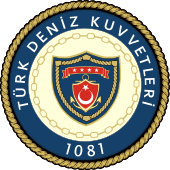 Seal of the Turkish Navy | |
| Founded | |
| Country | |
| Type | Navy |
| Role | Naval warfare |
| Size | 48,600 personnel[3] 51 aircraft [4] |
| Part of | Turkish Armed Forces |
| Headquarters | Ankara |
| Motto(s) | "Always Ready" |
| Colors | Blue, White & Gold |
| March | Turkish Navy March |
| Anniversaries | September 27[1] |
| Website | dzkk.tsk.tr/ |
| Commanders | |
| Commander-in-Chief | President Recep Tayyip Erdoğan |
| Minister of National Defence | Minister Hulusi Akar |
| Chief of the General Staff | General Yaşar Güler |
| Commander | Admiral Adnan Özbal |
| Insignia | |
| Flag of Turkish Naval Forces Command | |
| Naval Aviation Roundel |  |
| Masthead Pennant | |
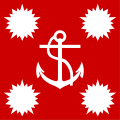 |
| Components |
|---|
|
| Special Forces |
|
| History |
|
| Equipment |
|
 |
| Branches |
|---|
| History |
| Special forces |
| Member of |
| Current overseas deployments and missions[5] |
The navy can trace its lineage back to the first Turkish fleets to sail the Aegean in the late 11th century, the fleets of the Anatolian beyliks in the 14th century, and, more recently, to the Ottoman Navy. However, the modern naval traditions and customs of the Turkish Navy can be traced back to 10 July 1920, when it was established as the Directorate of Naval Affairs during the Turkish War of Independence led by Mustafa Kemal Atatürk. Since July 1949, the service has been officially known as the Turkish Naval Forces.
In 2008, the Turkish Navy had a reported active personnel strength of 48,600; this figure included an Amphibious Marines Brigade as well as several Special Forces and Commando detachments.[3] As of early 2015, the navy operates a wide variety of ships and 51 maritime aircraft.
History
Ottoman fleet after Mudros
_issued_by_Kinney_Tobacco_Company_to_promote_Sweet_Caporal_Cigarettes_MET_DPB874366.jpg)

Following the demise of the Ottoman Empire in the aftermath of World War I, on November 3, 1918, the fleet commander of the Ottoman Navy, rear admiral Arif Pasha, ordered all flags to be struck on all warships lying in the Golden Horn, and the Ottoman Navy ceased to exist. The major surface combatants of the former Ottoman fleet (totalling 62,000 tons) were rendered inactive by the Allies and in accordance with the terms of the Armistice of Mudros, the warships were disarmed during the last week of 1918. The battleship Turgut Reis and the cruisers Hamidiye and Mecidiye were substantially limited and kept inactive inside the Golden Horn by the occupying forces.[7] Due to its larger size, the battlecruiser Yavuz Sultan Selim was transferred to the Gulf of Izmit on the grounds that she could adversely affect the sea traffic inside the Golden Horn;[7] while her ammunition and guns were removed.[7] During this period, only a small number of Ottoman Navy vessels were allowed by the Allies to remain on active coast guard duties and were released from internment on 26 February 1919; such as the torpedo boats Akhisar and Dıraç which patrolled the Sea of Marmara, the gunboat Hızır Reis which patrolled the Gulf of İzmir, and the minelayers Nusret and Tir-i Müjgan which conducted mine cleaning operations in the Gulf of Saros.[7]
Before the Turkish War of Independence began, the Bahriye Nazırlığı (Naval Ministry) sent the gunboat Preveze to Sinop and the gunboat Aydın Reis to Trabzon in February 1919 for surveillance, reconnaissance and patrol duties.[7] However, a lack of coal to fuel their propulsion systems caused the Preveze and Aydın Reis to remain in harbour until the end of 1919.[7] During the early stages of the Turkish War of Independence, these two gunboats did not return to Istanbul, despite heavy pressure from the Ottoman government and the Allies.[7] Instead, they were placed under the command of the Turkish liberation forces led by Mustafa Kemal Atatürk and headquartered in Ankara.[7]
Turkish War of Independence
Directorate of Naval Affairs
A large number of the naval officers and students of the Naval Academy went to Anatolia for participating in the Turkish War of Independence. On 10 July 1920, the Directorate of Naval Affairs (Umur-u Bahriye Müdürlüğü) was founded in Ankara under the Ministry of National Defense and was given the duty of organizing and maintaining strategic logistical shipping through the Black Sea in order to provide the Turkish liberation forces in Anatolia with weapons and other supplies.[7] All existing naval institutions in the parts of Anatolia that were administered by the Ankara government were assigned to this Directorate.[7] The Directorate of Naval Affairs was extremely successful in organizing local surface units and volunteers and in forming an intelligence network to discover the movements of the enemy ships.[7] As a result, logistic transportation was carried out effectively.[7] The Turkish Grand National Assembly in Ankara made an agreement with the Soviet Union to procure supplies for the Turkish liberation forces.[7] Aydın Reis left from Samsun (on 16 September 1920) and Preveze left from Trabzon (on 30 September 1920) for Novorossiysk in order to transport weapons, other supplies and financial aid to the Turkish liberation forces.[7] The Trabzon Shipping Detachment, which was founded on 21 September 1920, was renamed as the Trabzon Naval Shipping Command with the directive issued by the Ministry of National Defense on 26 October 1920.[7] On January 1, 1921, the Samsun Naval Command was formed.[8] In the subsequent stages of the Turkish War of Independence, due to the growing need for maritime shipping and the increase in the quantity and quality of the units and small ships, the organizational structure of the Directorate of Naval Affairs was gradually extended.[7]
In the same period, a number of Turkish civilian seamen formed a group under the name of the Naval Aid Organization (Muavenet-i Bahriye).[8] This group secretly obtained cannons, light weapons, ammunition, landmines and ordnance from the former Ottoman military warehouses in Istanbul that were under the control of the occupying Allies and sent them to the Turkish liberation forces in Anatolia with civil water transportation crafts.[8]
Presidency of the Naval Department
On 1 March 1921, the Directorate of Naval Affairs was transformed into the Presidency of the Naval Department (Bahriye Dairesi Reisliği) and had control over the Naval Commands in Samsun, Amasra and İzmit (formed on 28 June 1921); the Naval Transport Detachment in Trabzon; the Naval Transport Command in Ereğli; the Naval Detachment in Lake Eğirdir; and the Naval Liaison Group in Fethiye (formed on 16 March 1921.)[7] During the War of Independence, Turkish naval forces transported 220,000 tons of weapons, ammunition and equipment to the land forces in Anatolia.[8]
Ministry of the Navy
Following the Armistice of Mudanya on 11 October 1922, the former Ottoman Ministry of the Navy (Bahriye Nazırlığı) building in the Kasımpaşa quarter of Istanbul, on the Golden Horn, became the headquarters of the Istanbul Naval Command on 14 November 1922.[7] The establishment of the Ministry of the Navy (Bahriye Vekâleti) of the Republic of Turkey, headquartered in Ankara, was decided by the Grand National Assembly on 29 December 1924, and Topçu İhsan Bey (İhsan Eryavuz) was appointed the first (and only) Naval Minister of Turkey.[9][10] When the Republic of Turkey was established on 29 October 1923, the former Ottoman vessels that remained under Turkish control were as follows:
In active service: 2 cruisers (Hamidiye, Peyk-i Şevket), 2 yachts (Ertuğrul, Söğütlü), 1 destroyer (Taşoz), 4 gunboats (Burak Reis, Hızır Reis, Kemal Reis, İsa Reis), 1 minelayer (Nusret), 1 aviso (Galata), 4 tugs and 7 motorboats. Out of service (needing repair): 2 battleships (Yavuz Sultan Selim, Turgut Reis), 2 cruisers (Berk-i Satvet, Mecidiye), 4 destroyers (Muâvenet-i Millîye, Nümune-i Hamiyet, Basra, Samsun), 6 torpedo boats (Sultanhisar, Yunus, Akhisar, Dıraç, Musul, Berk Efşan), 1 gunboat (Sakız).
Preparations were made to carry out the maintenance and overhaul of small-tonnage warships (the three Taşoz-class destroyers and the gunboats Burak Reis, Sakız, İsa Reis and Kemal Reis) and to make them combat-ready.[7] Thus, the cruiser Hamidiye, which was planned to be employed as a Cadet Training Ship, was overhauled.[7]
During the 1920s, a commitment to refurbish the battlecruiser TCG Yavuz (which remained in active service until 1950) as the centerpiece of the republic's fleet was the only constant element of the various naval policies which were put forward.[12] The battlecruiser remained in İzmit until 1926, in a neglected state:[13][14][15] only two of her boilers worked, she could not steer or steam, and she still had two unrepaired scars from the mine damage in 1918. Enough money was raised to allow the purchase of a new 26,000-metric-ton (26,000-long-ton) floating dock from the German company Flender,[7] as Yavuz could not be towed anywhere without risk of her sinking in rough seas.[16] The French company Atelier et Chantiers de St. Nazaire-Penhöet was contracted in December 1926 to oversee the subsequent refit, which was carried out by the Gölcük Naval Shipyard.[14] Since the Treaty of Lausanne in 1923 required the disarmament of the Turkish Straits, the infrastructures belonging to the Turkish Naval Forces on the Bosphorus (in Istinye) and on the Golden Horn were transferred to Gölcük.[7] In this period, Gölcük was designated as the main Turkish naval base.[7]
The overhaul works of TCG Yavuz proceeded over three years (1927–1930); they were delayed when several compartments of the dock collapsed while being pumped out. Yavuz was slightly damaged before she could be refloated and the dock had to be repaired before the overhaul works could be resumed. The Minister of the Navy, İhsan Eryavuz, was convicted of embezzlement in the resulting investigation which became known as the Yavuz-Havuz case (havuz meaning "dock" in Turkish naval engineering terminology.)[16] The investigation revealed that Ihsan Eryavuz had reduced the insurance obligation of the French company (Atelier et Chantiers de St. Nazaire-Penhöet) from 5 million to 1.5 million Turkish liras, and was convicted guilty of fraud,[17] which resulted in the abolition of the Ministry of the Navy on 27 December 1927.[8][18]
Undersecretariat of the Sea
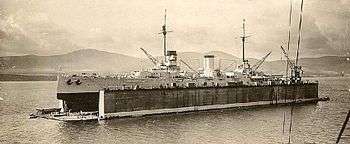
Following the dissolution of the Ministry of the Navy, the naval forces were reorganized under the Ministry of National Defense[10] and on 16 January 1928[18] the Undersecretariat of the Sea (Deniz Müsteşarlığı) was established in order to undertake the duties of the former Ministry of the Navy.[8] With this new reorganization, the Turkish Fleet Command was put under the command of the Turkish General Staff in terms of administration and logistics.[7] On 2 November 1930, the Naval War College (Deniz Harp Akademisi) commenced training and education of Staff Officers at its facilities in the Yıldız Palace.[7] During World War II, the naval schools were temporarily relocated from Istanbul to Mersin for security reasons and conducted education and training activities in this city.[7]
In 1933, with the approval of the Turkish Grand National Assembly, Gölcük was designated as the main base of the Turkish Navy.[7] In the same year, the first new ship built at the Gölcük Naval Shipyard, the tanker TCG Gölcük, was laid down; and launched the following year.[7] With the signing of the Montreaux Convention in 1936, Turkey's sovereignty over the Turkish Straits was internationally recognized, and Fortified Area Commands were founded on the Bosphorus and Dardanelles straits, with Naval Detachments assigned to these Commands.[7]
Naval Forces Command
The Turkish Naval Forces were represented under the title of the Naval Undersecreteriat at the Turkish General Staff Headquarters in Ankara from 1928 to 1949.[7] The historic decree of the Higher Military Council on 15 August 1949 led to the foundation of the Turkish Naval Forces Command (Deniz Kuvvetleri Komutanlığı.)[7] After Turkey joined NATO on 18 February 1952, the Turkish Naval Forces were integrated into the organizational branches of the alliance.[7]
Structure
%2C_USS_Harry_S._Truman_(CVN_75)_and_the_Italian_aircraft_carrier_ITS_Giuseppe_Garibaldi_(C_551)_steam_through_the_Atlantic_Ocean_while_participating_in_Majestic_Eag.jpg)
.jpg)
In 1961, the Turkish Naval Forces Command was organized into four main subordinate commands: The Turkish Fleet Command, the Turkish Northern Sea Area Command, the Turkish Southern Sea Area Command and the Turkish Naval Training Command.[7] In 1995, the Turkish Naval Training Command was renamed as the Turkish Naval Training and Education Command.[7]
Current Structure
- Fleet Command, Gölcük Naval Base, Kocaeli
- Surface Action Group Command, Gölcük Naval Base, Kocaeli
- Submarine Group Command, Gölcük Naval Base, Kocaeli
- Fast Patrol Boat Group Command, İstanbul
- Mine Warfare Group Command, Erdek Naval Base, Balıkesir
- Logistic Support Group Command, Gölcük Naval Base, Kocaeli
- Naval Aviation Group Command, Cengiz Topel Naval Air Station, Kocaeli
- Gölcük Naval Base Command, Kocaeli
- Gölcük Naval Shipyard Command, Kocaeli
- Inventory Control Center Command, Kocaeli
- Marine Supply Center Command, Kocaeli
- Yıldızlar Surface Training Center, Gölcük, Kocaeli
- Northern Sea Area Command, İstanbul
- Istanbul Strait Command, Anadolukavağı, İstanbul
- Çanakkale Strait Command, Nara, Çanakkale
- Black Sea Area Command, Karadeniz Ereğli, Zonguldak
- Rescue and Underwater Command, Beykoz, İstanbul
- Rescue Group Command
- Underwater Defence Group Command
- Naval Hydrography and Oceanography Division Command, Çubuklu, İstanbul
- Bartın Naval Base Command, Bartın
- Naval Museum Command, Beşiktaş, İstanbul
- Istanbul Naval Shipyard Command, Pendik
- Southern Sea Area Command, İzmir
- Amphibious Task Group Command, Foça, İzmir
- Amphibious Marine Brigade Command, Foça, İzmir
- Amphibious Ships Command, Foça, İzmir
- Aksaz Naval Base Command, Aksaz Naval Base, Marmaris
- Mediterranean Area Command, Mersin
- İskenderun Naval Base Command, İskenderun, Hatay
- Agean Sea Area Command, İzmir
- Foça Naval Base Command, Foça, İzmir
- Maintenance, Repair and Engineering Command, İzmir
- Amphibious Task Group Command, Foça, İzmir
- Naval Training and Education Command, İstanbul
Marines and Special Forces
The Turkish Navy maintains marine, explosive ordnance disposal and special operations units such as:
- Amphibious Marine Brigade Command – (Turkish: Amfibi Deniz Piyade Tugayı Komutanlığı, AMFİBİ), (Subordinate to Amphibious Task Group Command)
- Underwater Defence Group Command – (Turkish: Sualtı Savunma Grup Komutanlığı, SAS), (Subordinate to Rescue and Underwater Command)
- Underwater Offence Group Command – (Turkish: Sualtı Taarruz Grup Komutanlığı, SAT), (Directly Subordinate to Naval Forces Operations Department)
Equipment
Ships and submarines
As of 2015, the navy operates a wide variety of ships, including; 16 frigates, 10 corvettes, 12 submarines, 19 missile boats, 16 patrol boats, 11 mine countermeasures vessels, 33 landing ships, and various auxiliary ships. In 2002, the total displacement of the Turkish Navy was approximately 259,000 tonnes.[19]
Aircraft
The Turkish Navy operates a total of 50 aircraft, including 15 fixed-wing aircraft and 35 helicopters.
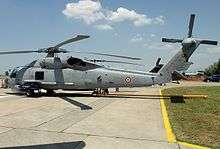
_direct_a_Turkish_helicopter_during_a_vertical_replenishment.jpg)
| Aircraft | Origin | Type | Versions | Quantity[4] | Notes |
|---|---|---|---|---|---|
| Fixed-wing aircraft | |||||
| ATR 72 MPA | Maritime Patrol (ASW/ASuW) Transport Aircraft |
72-600 TMPA 72-600 TMUA |
– 2[20] |
8 being upgraded by Turkish Aerospace Industries[21][22][23] | |
| CASA CN-235 | Maritime Patrol (ASW/ASuW) | CN-235-100M | 6[20] | Electronic systems upgraded by Thales[24][25] | |
| SOCATA TB family | Trainer Aircraft | TB-20 | 7[26] | ||
| Helicopters | |||||
| Sikorsky S-70B-28 Seahawk | Maritime Helicopter (ASW/ASuW) | S-70B-28 | 24[27] | 6 more on order[26] | |
| Agusta-Bell AB-212 ASW | Maritime Helicopter (ASW) | Anti-Submarine Warfare
|
9[28]
2[29] |
||
Insignia
| NATO code | OF-10 | OF-9 | OF-8 | OF-7 | OF-6 | OF-5 | OF-4 | OF-3 | OF-2 | OF-1 | OF(D) | Student officer | ||||||||||||||||||||||||
|---|---|---|---|---|---|---|---|---|---|---|---|---|---|---|---|---|---|---|---|---|---|---|---|---|---|---|---|---|---|---|---|---|---|---|---|---|
(Edit) |
 |
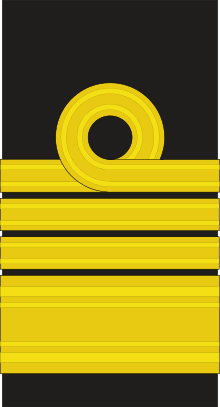 |
 |
 |
 |
 |
 |
 |
 |
 |
 |
 |
Various [note 1] | |||||||||||||||||||||||
| Büyükamiral | Oramiral | Koramiral | Tümamiral | Tuğamiral | Albay | Yarbay | Binbaşı | Yüzbaşı | Üsteğmen | Teğmen | Asteğmen | Bahriyeli | ||||||||||||||||||||||||
| NATO Code | OR-9 | OR-8 | OR-7 | OR-6 | OR-5 | OR-4 | OR-3 | OR-2 | OR-1 | |||||||||||||||||||||||||||
|---|---|---|---|---|---|---|---|---|---|---|---|---|---|---|---|---|---|---|---|---|---|---|---|---|---|---|---|---|---|---|---|---|---|---|---|---|
(Edit) |
 |
 |
 |
 |
 |
 |
 |
 |
 |
 |
 |
 |
No insignia | |||||||||||||||||||||||
| Astsubay Kıdemli Başçavuş |
Astsubay Başçavuş |
Astsubay Kıdemli Üstçavuş |
Astsubay Üstçavuş |
Astsubay Kıdemli Çavuş |
Astsubay Çavuş |
Kıdemli Uzman Çavuş |
Uzman Çavuş |
Çavuş | Kıdemli Uzman Onbaşı |
Uzman Onbaşı |
Onbaşı | Er | ||||||||||||||||||||||||
- Non-Turkish speakers might like to know that OF3, OF2, and OR2 literally translates as "Head of 1000", "Head of 100", and "Head of 10", respectively.
Future of the Turkish Navy
.jpg)
The Turkish Navy is currently undergoing several modernisation programmes to replace its ageing equipment. As of 2013, the major modernisation projects are as follows:
- The construction works of twelve MILGEM project warships (4 Ada class corvettes and 4 TF-100 class frigates) are currently ongoing.[36] The first vessel, F-511 TCG Heybeliada, was commissioned in 2011; and the second vessel, F-512 TCG Büyükada, was commissioned in 2013.[36], 3rd of the MILGEM Ada class corvettes, F-513 TCG Burgazada was commissioned in November 2018 [37].
- The construction of four Istanbul class (I class) frigates.
- Plans to build a total of four TF-2000 class air-defence frigates with the option for two more.[38][39]
- The contract for the acquisition of six Type 214 AIP submarines was signed by the Turkish Ministry of Defense on 2 July 2009 and entered into effect on 22 June 2011.[40][41]
- TCG Anatolia (L-400) amphibious assault ship / aircraft carrier is scheduled to enter service by 2021. The construction of an identical sister ship, to be named TCG Trakya, is currently being planned by the Turkish Navy.[34][35]
- New LST class (+2 approved on 12 December 2006 and will be based on LCM-1E)[42][43]
- New LCT class (+8 approved on 12 December 2006)[42]
- New Auxiliary Oil Replenishment (AOR) Ship[44]
- Submarine Rescue Mother Ship (+1 approved)[44][45]
- Rescue & Towing Ship (+2 approved)[44][46]
- New Type Su Altı Taarruz Boat Project
- Fast Intervention Boat Project
- Air-cushioned landing craft Project
- Additional purchases of several S-70B Seahawks
- Distant Horizon Project (Recognized Maritime Picture)
- Modernization projects for all existing major surface ships
See also
Notes
- Student officer insignia denotes school grade rather than military seniority.
References
- History of Turkish Naval Forces (Official Turkish Naval Forces website)
- 1949 Temmuzunda Türk Silâhlı Kuvvetleri yeniden örgütlendirilerek, Genelkurmay Başkanlığına bağlı Kara, Deniz, Hava Kuvvetleri kuruldu., Genelkurmay Başkanlığı, Türk Tarihi, Silahlı Kuvvetleri ve Atatürkçülük, Genelkurmay Başkanlığı, 1973, p. 65. (in Turkish)
- Library of Congress - Federal Research Division (August 2008), Country Profile: Turkey (PDF), pp. 25–26
- "About the FlightGlobal Group - AirSpace Announcement". Flightglobal.com.
- "Türk Silahlı Kuvvetlerinin Barışı Destekleme Harekâtlarına Katkıları". tsk.tr. Retrieved 18 June 2014.
- "Hata Sayfası". Retrieved 14 December 2014.
- Cevat Ülkekul, "Kurtuluş Savaşı'nda Türk Denizcileri ve Cumhuriyet Bahriyesinin Kuruluşu" ("Turkish Seamen during the War of Independence and Establishment of the Republican Navy"), Uluslararası Piri Reis Sempozyumu, 27-29 Eylül 2004 (Bildiri), Office of Navigation of Hydrography and Oceanography. (in Turkish)
- Ümit Özdağ, Atatürk ve İnönü dönemlerinde Ordu-Siyaset İlişkisi, Bilgeoğuz, 2006, p. 97. (in Turkish)
- Türkiye Diyanet Vakfı İslâm ansiklopedisi, Vol 12, Türkiye Diyanet Vakfı, İslâm Ansiklopedisi Genel Müdürlüğü, 1988, (in Turkish)
- Güvenç and Barlas, p. 7
- Gardiner and Gray, p. 391
- Whitley, p. 241
- Worth, p. 271
- Brice, p. 277
- "The Yavuz-Havuz Case (Turkish)". Retrieved 27 October 2015.
- Genel Tarihçe, Turkish Navy official site.
- "(no title)". Retrieved 27 October 2015.
- "Türk Deniz Kuvvetleri Komutanlığı". www.dzkk.tsk.tr. Retrieved 2020-08-19.
- Turkish Aerospace Industries, Inc. "MELTEM III (ATR-72)". Turkish Aerospace Industries, Inc. Retrieved 14 December 2014.
- "Alenia Aermacchi Delivers First ATR72-600 TMUA to Turkish Navy". July 24, 2013.
- "Raytheon to provide torpedo integration for Turkish Navy ATR-72-600ASW maritime patrol aircraft". July 17, 2014.
- Turkish Aerospace Industries, Inc. "MELTEM II (CN-235)". Turkish Aerospace Industries, Inc. Archived from the original on 10 December 2014. Retrieved 14 December 2014.
- "Thales finalises delivery of MELTEM II CASA CN-235 maritime patrol aircraft to Turkey". April 28, 2014.
- "World Air Forces 2013" (PDF). Flight Global. Flight Global.
- "Türk Deniz Kuvvetleri Komutanlığı". www.dzkk.tsk.tr. Retrieved 2020-08-19.
- "Türk Deniz Kuvvetleri Komutanlığı". www.dzkk.tsk.tr. Retrieved 2020-08-19.
- "Türk Deniz Kuvvetleri Komutanlığı". www.dzkk.tsk.tr. Retrieved 2020-08-19.
- "The Construction Of The Multipurpose Amphibious Assault Ship TCG Anadolu Has Started". Bosphorus Naval News. 2 May 2016.
- "Technical specifications of TCG Anadolu (L-400)". Turkishnavy.net. 2 May 2016.
- Ahmet Doğan (2019-11-09). "TCG Trakya ne zaman bitecek?". DenizHaber.com.
- Anıl Şahin (2019-02-14). "Deniz Kuvvetlerinden TCG Trakya açıklaması". SavunmaSanayiST.com.
- "Turkish Naval Forces". Retrieved 27 October 2015.
- Acar, Cemal (4 November 2018). "3rd of the MILGEM Ada class corvettes, F-513 TCG Burgazada was commissioned to Turkish #Navy after the ceremony. At the ceremony, 4th reis class #submarine S-333 TCG Aydınreis's first welding was conducted by Turkish President.pic.twitter.com/TYXilm1zhO". twitter.com.
- "Turkish Naval Forces: Frigate Projects". Retrieved 18 March 2015.
- "Anti-air Warfare Ship (TF 2000) Project". Retrieved 27 October 2015.
- "New Type Submarine Procurement Project". Retrieved 27 October 2015.
- "UPDATE 3-Turkey in $4 bln submarines deal with HDW". Retrieved 14 December 2014.
- "Amphibious Ship". Retrieved 27 October 2015.
- "Turkish Shipyard ADIK showcasing its Landing Ship Tank (LST) project at IDEF 2013". May 8, 2013.
- "Turkish Naval Forces". Retrieved 27 October 2015.
- "Submarine Rescue Mother Ship (MOSHIP) Project". Retrieved 27 October 2015.
- "Rescue and Towing Ship (R&T Ship) Project". Retrieved 27 October 2015.
External links
| Wikimedia Commons has media related to Naval ships of Turkey. |
- Turkish Navy – Official website
- Turkish Naval Museum – Official website
- Bosphorus Naval News – Latest news, photos and fleet data regarding the Turkish Navy
- Serhat Guvenc, "Building a Republican Navy in Turkey: 1924-1939", International Journal of Naval History
- Undersecretariat for Defence Industries